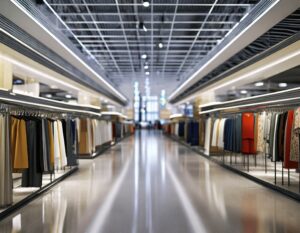The Dallas-Fort Worth retail market has experienced a significant upswing in demand over the past two years, leading to an unprecedented decrease in available leasing space due to a combination of steady demand and limited supply. This period has seen a remarkable level of leasing activity, with the market absorbing 37 million square feet from 2021 to this year, significantly more than the space vacated by tenants, thereby reinforcing its position as a national leader in net absorption.
Tenant interest in both urban and suburban areas has been on the rise, creating a competitive environment for prime locations. Concurrently, developers are cautiously constructing 5.1 million square feet in the area, with 66% of this space already preleased. Sectors such as home goods, discount stores, and food and beverage outlets primarily drive this demand. Concurrently, development in the area has been cautious, with 5.1 million square feet currently under construction, 66% of which is already pre-leased. This approach, particularly prevalent in rapidly growing suburban areas, has contributed to maintaining low vacancy rates.
A notable trend in the market is the transformation of outdated malls into mixed-use developments, with significant projects like Red Bird Mall and Collin Creek Mall leading to the removal of 2.5 million square feet of space, thereby contributing to market rightsizing. However, the pace of sales activity has slowed, affected by rising interest rates and pricing discrepancies between buyers and sellers. Despite these challenges, there is still available capital, with a focus on multi-tenant buildings in both urban and suburban settings.
Looking ahead, the Dallas-Fort Worth retail market appears well-positioned for continued strength, supported by a combination of limited supply, low availability, and ongoing demographic and economic growth, even in the face of potential economic downturns.
Page Contents
- Grocery and Discount Retailers on the Rise
- Affluent Areas Leading with Premium Rental Rates
- Innovative Retail Transformations: Reimagining DFW’s Commercial Spaces
- Measured Pace in Retail Space Development
- Shift to Smaller Centers and Mixed-Use Developments
- Concentration of Construction Activity in Northern Counties
- Renovation and Repurposing in High Traffic Areas
- Reimagining Underperforming Retail Assets
- The Shift in Retail Deal Dynamics Amid Rising Interest Rates
- Changing Capital Markets and Interest Rate Impacts
- Investor Focus on High-Quality Suburban Shopping Centers
- Repurposing Mall Spaces: A Growing Trend
- Closing Thoughts
Grocery and Discount Retailers on the Rise
Consistent Leasing and Leading Net Absorption
Over the past two years, Dallas-Fort Worth has maintained a steady pace in leasing activity, aligning with pre-crisis levels and establishing itself as a national leader in net absorption. As a result, vacancy and availability rates have been trending near or below pre-crisis norms.
 Bright Market Outlook with Economic and Demographic Support
Bright Market Outlook with Economic and Demographic Support
The Dallas-Fort Worth retail market maintains a positive outlook, bolstered by structural economic and demographic factors expected to sustain retail demand over the long term.
Robust Demand and Diverse Tenant Interest
Brokerage leaders have noted a sustained interest from retailers looking to establish or expand their presence in the Dallas-Fort Worth area. This leasing activity is characterized by retailers actively filling spaces vacated during the recent downturn. Additionally, big-box retailers and national grocers are actively expanding in areas with strong demographic profiles. The majority of leases in the metroplex are for spaces under 5,000 SF, with smaller tenants representing about half of the total Retail Building Area (RBA) leased in the past year.
Expansion of Grocers and Discount Retailers
The Dallas-Fort Worth area is witnessing an expansion of grocery stores, including San Antonio-based H-E-B, which has leased a 58,904 SF space for its discount banner, Joe V’s Smart Shop, in south Dallas. The grocer is also opening new stores in Plano, McKinney, and Frisco, targeting demographic growth in Collin County. Discount retailers are on the rise too, with Dollar General’s new concept, pOshelf, securing 57,297 SF across seven locations, primarily in established suburban areas in Tarrant, Collin, and Rockwall counties.
Forecast: Balanced Absorption and Vacancy Rates
CoStar’s anticipates a slight reduction in absorption due to slower consumption patterns, while maintaining a manageable construction pipeline. Expectations are for this to maintain balanced vacancy rates, keeping the retail segment relatively solid in the event of a consumption pullback.
Affluent Areas Leading with Premium Rental Rates
Robust Rent Growth Outpacing National Trends
In Dallas-Fort Worth, rent growth has notably exceeded expectations and surpassed the national average, primarily due to limited construction activity and decreasing space availability. Recent trends show a deceleration in rent growth, mirroring a similar pattern observed at the national level. The forecast from industry analysts anticipates a further deceleration in rent growth in the near term, driven by a reduction in consumption and space demand.
Consistent Superior Performance in Rent Increases
Throughout the recent expansion period, the metro area has experienced an average annual rent growth of over 3% for the past five years, consistently outperforming the U.S. average. More affluent areas with substantial purchasing power, such as North Dallas, Uptown, Frisco, and Southlake, command the region’s highest rental rates, with average rents ranging from $30/SF to $45/SF, significantly above the market average.
Demographic Influence on Long-Term Retail Performance
Demographics will likely shape the retail sector’s performance in the metroplex over the long term. While Dallas-Fort Worth is adding supply at one of the fastest rates in the country, it is also experiencing rapid household growth. This new household formation, coupled with rising incomes, is anticipated to sustain the demand for retail space and support ongoing rent growth in the area.
Innovative Retail Transformations: Reimagining DFW’s Commercial Spaces
Measured Pace in Retail Space Development
Developers in Dallas-Fort Worth are adding retail space at a cautious pace. Despite the metroplex being one of the top markets for retail construction in terms of square footage, the ongoing projects represent less than 1% of the total inventory. Last year saw the initiation of 3.6 million square feet of retail space, marking the lowest level of new development since 2011.
Shift to Smaller Centers and Mixed-Use Developments
The focus of new retail projects has shifted from the large super-regional malls of the past to smaller centers and mixed-use developments. This strategy helps in reducing the risk of oversupply. The current construction projects are also seeing high preleasing rates, with 74% of the retail space under construction pre-leased. Larger retail spaces are mostly being integrated into broader mixed-use projects, such as CityLine in Richardson, Legacy West in Plano, Water Street and the Music Factory in Las Colinas, and various major projects in Frisco.
Concentration of Construction Activity in Northern Counties
Construction activity is predominantly concentrated in the northern regions, particularly in Denton and Collin Counties, in communities like Allen, McKinney, Frisco, and Prosper. These areas are experiencing significant demographic growth, with about 65% of the ongoing retail space development located in Denton and Collin Counties, and Dallas County accounting for 15%.
Renovation and Repurposing in High Traffic Areas
Recently, the focus has shifted from new ground-up developments in outlying areas to renovating or repurposing existing assets along major traffic corridors. An example is the Shops at Willow Bend in West Plano, which underwent a $100 million renovation. Additionally, plans are in place to add a 200,000-SF office building next to the mall, enhancing its competitiveness with new developments in Collin County.
Reimagining Underperforming Retail Assets
Some property owners are taking bold steps to completely transform underperforming retail spaces. For instance, the Collin Creek Mall, a vintage mall from the 1980s, is being redeveloped into a $1 billion mixed-use project by Centurion American Development. Similarly, the Valley View Mall site is set for an ambitious mixed-use redevelopment that aims to redefine that section of North Dallas. Beck Ventures’ Dallas International District is another major project, planning to add 275,000 SF of retail space along with office and multifamily components.
redeveloped into a $1 billion mixed-use project by Centurion American Development. Similarly, the Valley View Mall site is set for an ambitious mixed-use redevelopment that aims to redefine that section of North Dallas. Beck Ventures’ Dallas International District is another major project, planning to add 275,000 SF of retail space along with office and multifamily components.
The Shift in Retail Deal Dynamics Amid Rising Interest Rates
Retail transaction activity in Dallas-Fort Worth has seen a decline, with deal volume stabilizing at around $4.5 billion over the past year, aligning with pre-crisis annual averages. This figure represents a decrease from the mid-2022 peak of $7.1 billion. Investors continue to show a strong interest in shopping centers anchored by essential retailers such as grocery stores, hardware outlets, and discount stores.
Changing Capital Markets and Interest Rate Impacts
The landscape of capital markets is undergoing significant changes, primarily due to rising interest rates that have increased the cost of borrowing. The Federal Reserve’s aggressive stance against inflation has led to rapid increases in the federal funds rate. This situation has created a gap between buyer and seller price expectations, resulting in a marked slowdown in dealmaking. Despite this, there is still capital ready for investment in Dallas-Fort Worth, but the uncertainty surrounding future rate hikes has led many investors to adopt a wait-and-see approach.
Investor Focus on High-Quality Suburban Shopping Centers
Shopping centers in prime suburban locations continue to attract investor interest. A notable transaction in 2022 was InvenTrust Realty Corp.’s acquisition of The Highlands of Flower Mound, a 147,500-SF shopping center, as part of a $38 million portfolio deal. The center, developed in 2003, lists Bed Bath & Beyond and Macy’s Backstage among its major tenants.
Repurposing Mall Spaces: A Growing Trend
There is a keen interest among investors and developers to repurpose mall spaces in the metroplex. For instance, MetLife Investment Management acquired the Galleria from UBS in late 2022, with plans to redevelop the mall to include multifamily and outdoor spaces, led by Trademark Property Co. Another example is the purchase of Music City Mall in Lewisville by 1000 South Vermont LLC from ICA Properties for $40 million in August 2022, with redevelopment plans still in the proposal stages. Additionally, investor Peter Brodsky’s acquisition of RedBird Mall for a mixed-use project highlights this trend. The project includes repurposing existing mall space for office use and plans for hospitality, outdoor retail, and green spaces. This trend is also attracting multifamily developers to historically underinvested areas.
Closing Thoughts
To sum up, the Dallas-Fort Worth retail market is a dynamic and constantly evolving landscape. It is defined by its prudent development strategies, significant rent growth, and shifting investment trends. Developers are strategically adding space, focusing on smaller centers and mixed-use projects, particularly in the rapidly growing northern counties of Denton and Collin. This approach aligns perfectly with current market demands and plays a crucial role in preventing oversupply. Additionally, rent growth in the region, driven by constrained construction and limited space availability, has consistently outperformed national averages. However, a recent slowdown in this growth reflects broader economic trends.
In terms of retail deal volume, while it has dipped from its mid-2022 peak, it remains strong, signaling a resilient market. The changing dynamics of the capital markets, influenced by rising interest rates and the increasing cost of debt, are leading investors to adopt a more cautious approach, with a marked preference for high-quality suburban shopping centers. Moreover, the trend of repurposing mall spaces into mixed-use developments is a testament to the market’s innovative response to evolving retail needs. These developments, along with demographic growth and strategic project placements, underscore the Dallas-Fort Worth area’s potential as a vibrant and attractive destination for retail investment and development. If you’re looking to navigate these complex market conditions for your retail acquisitions or dispositions, we can provide the expert guidance and insights you need to make informed decisions.